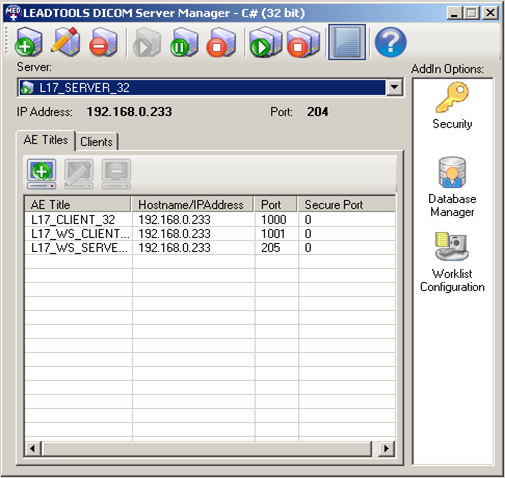The LEADTOOLS DICOM Server Manager Demo configures three different DICOM Servers by default. These DICOM Servers use the LEADTOOLS PACS Server Framework. Each DICOM Server implements different DICOM Services using different AddIns. Additionally, a Server Manager application is provided to configure and manage all of the servers from a single user interface.
Users can add or remove supported DICOM Services from any of the servers by simply adding or removing the Add-ins under the server folder. Please note that one Add-in can implement multiple DICOM Services but multiple Add-ins are not allowed to support the same DICOM service under a single server configuration.
Server Manager Demo:
The PACS Server Manager (CSLeadtools.Dicom.Server.Manager_Original.exe) is a sample application that uses the LEADTOOLS DICOM Service Admin SDK to allow users to manage multiple PACS Framework from one application. Users can add, remove and configure Servers; and start, stop and pause any or all server services. The application also allows DICOM client configuration for each server and exposes the add-in level settings for all configured Add-ins when implemented. In addition, users can view the transaction log of all servers from this application.
The following figure shows the LEADTOOLS DICOM Server Manager:

Server - The Server drop-down list box lists all configured DICOM Servers.
The following figure shows the configured PACS Framework Servers:
IP Address - The IP address of the selected server
Port - The Port to which the selected server is listening.
Selecting a server from the list box displays a list of icons under the Add-in Options List, as shown in the following figure:
Each icon represents an installed Add-in on the server. Double-clicking an icon displays the settings dialog for that Addin. For example, double-clicking the Security icon() displays the Security Options dialog as shown in the following figure:
Note:More detailed information of individual Add-ins is documented under the respective server documentation.
![]() Add DICOM Server button- Click to open the Add New Server dialog. The Add New Server dialog Settings tab is shown in the following figure:
Add DICOM Server button- Click to open the Add New Server dialog. The Add New Server dialog Settings tab is shown in the following figure:

The Add New Server dialog Settings Tab has the following fields:
Settings Tab
The Add New Server dialog Advanced tab is shown in the following figure:

The Add New Server dialog Advanced tab has the following fields:
Advanced Tab
After a Server is configured, a new directory is created in the application folder based on the AE Title of the server. For instance, if your application directory is c:\Dicom Servers\ and you created a server with the AE Title " L18_MWL_MPPS_SRV"; the new directory will be c:\Dicom Servers\ L18_MWL_MPPS_SRV\. This directory contains all of the settings for the new server as follows:
Edit Server Button - For editing or change the configuration of an existing DICOM Server.
Delete Server button - Used for deleting a configured DICOM Server.
Start Server button - Used to start DICOM Server Service for the selected server from drop-down list box. A service's running state is indicated by a green circle and white triangle() next to server name.
Start All Servers button - Used to start all configured DICOM server services.
Pause Server button - Used to Pause the currently selected service.
Stop Server Button- Used to stop the currently selected DICOM Server Service.
Stop All Servers button - Used to stop all DICOM Server Services.
Log button- Used for viewing the DICOM message log. Clicking the Log button opens Event Log dialog, as shown in the following figure:
The Event Log Dialog has the following fields:
List View - Displays summary information.
Query Options Pane - Allows basic filtering of event log reports. The Query Options pane is shown in the following figure:
The Query Options Pane has the following fields:
Query Button - Click the Query button to refresh the list view to display the results of the search using the criteria specified in the Query Options Pane.
Detail ButtonClick the Detail button to open the Event Log Details dialog. The dialog is shown in the following figure:
The Event Log Details dialog has the following fields:
- Server AE Title - The Server AE Title
- Server IP Address - Server's IP Address
- Server Port- Port number the server is using
- Client AE Title - The Client AE Title
- Client IP Address - Client's IP Address
- Client Port- Port number the server is using
- Event Date/Time- The date and time at which the event occurred.
- Description - Event description
- View Dataset - Opens the dataset for viewing.
- Close - Closes the dialog.
Delete Selected Button - Click the Delete Selected button to delete the selected message. The following dialog displays:
Click Yes to remove the selected log message. Click No to close the dialog and return to the Event Log dialog.
Delete All Button - Click the Delete All button to delete all messages. The following dialog displays:
Click Yes to remove the log messages. Click No to close the dialog and return to the Event Log dialog.
Close Button - Click the Close button to close the dialog.
AE Titles Tab - This tab shows the configured list of clients for the currently selected server while a server service is running. The server register IAeTitle implementation is responsible for handling the Service Manager requests. The following actions are available on the AE Titles Tab:
Add AE Title button - Configures a new client connection. Clicking the button displays the following dialog:

Edit AE Title button -Use this to edit an existing client configuration. Enabled when a client is selected from the current client list. Clicking the button opens an Edit AE Title dialog similar to the Add AE Title dialog.
Note: Double-clicking a client list item also displays the Edit AE Title dialog.
Delete AE Title - Deletes the selected client configuration.
LEADTOOLS installs the following sample PACS Framework Servers Demos: